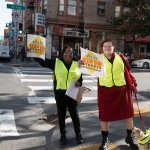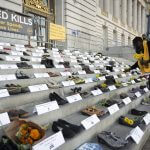The proposed speed camera locations are here. Here’s our take.
At long last, speed cameras, a proven, lifesaving technology is coming to our very own streets – where the #1 cause of severe and fatal traffic crashes continues to be speeding.
Today, the SFMTA posted a map where it proposes piloting 33 speed camera systems in San Francisco.
On the afternoon of Tuesday, March 19, SFMTA staff will present and discuss the locations with the SFMTA Board – with the SFMTA Board voting on these locations on Tuesday, April 16.
We invite you to join us at City Hall at both meetings to give public comment in support of the SFMTA’s work launching lifesaving speed cameras ASAP – and as strategically as possible.
The SFMTA’s map and our list from the map
You can view the map of proposed speed camera locations on page 12 of the slides for Tuesday’s SFMTA Board meeting.
We took the map and pieced together a list of the proposed areas here:
District 1 (3 cameras): Fulton near Arguello; Fulton near 42nd; Geary near 7th
District 2 (2 cameras): Bay near Octavia; Franklin near Union
District 3 (3 cameras): Columbus near Lombard; Broadway near Powell; Embarcadero near Green
District 4 (2 cameras): Lincoln near 27th; Sloat near 41st
District 5 (2 cameras): Geary near Webster; Turk near Van Ness
District 6 (7 cameras): Mission near 8th; 7th Street near Harrison; 10th near Harrison; 9th near Bryant; Harrison near 4th; Bryant near 2nd; King near 4th
District 7 (2 cameras): Ocean near Frida Kahlo; Monterey near Edna
District 8 (2.5 cameras): Market near Danvers; San Jose near 29th; Guerrero near 19th **on district line with District 9**
District 9 (2.5 cameras): Guerrero near 19th **on district line with District 8**; 16th near Bryant; Cesar Chavez near Folsom
District 10 (3 cameras): Cesar Chavez near Indiana; 3rd Street near Key; Bayshore near 101
District 11 (4 cameras): Geneva near Prague; San Jose near Santa Ynez; Mission near Ottawa; Alemany near Farragut
Walk SF’s take on the proposed locations for speed cameras
As a starting point, it’s important to know that AB 645 – the bill we helped to pass in 2023 allowing San Francisco and five other cities to pilot speed cameras – only allows cameras on streets with the highest crash rates (designated “high-injury” streets), or in school zones, or on a street with documented speed racing.
In addition, cameras must be placed in communities that are geographically and socioeconomically diverse. Once placed, speed cameras are assessed after 18 months and must be moved if they aren’t effective in one of three ways: 1) reducing the 85th percentile speed of vehicles compared to pre-camera data collected; 2) 20% reduction in drivers going faster than 10 MPH above the posted speed limit compared to pre-camera data collected; and 3) a 20% in the number of violators who received two or more violations at the location since the speed cameras became operational.
From the beginning, SFMTA’s approach to camera placement has been data-based. The SFMTA gathered a range of data on 70+ streets with serious speed issues, the highest crash rates, and high traffic levels to determine where cameras are needed most. This data collection is reflected in the published map of the 33 speed camera locations.
Here are some of our takeaways from the proposed locations:
Distribution within the 11 districts. Each district will get two to four cameras. District 6, which includes South of Market, Mission Bay, and Treasure Island, stands out as getting seven cameras. Given the high concentration of high-injury streets, highway touch-downs and speed-related collisions in South of Market, this makes sense.
Placement near many city entry points. We are glad to see locations in many major “entry point” areas of the city so that drivers from elsewhere immediately get the message that speed is camera-enforced in San Francisco.
Some very wide, deadly streets will get cameras. 9th, 10th, and Harrison Streets are being proposed for cameras – and we know from Walk SF’s own speed surveys that speeds here can be off the charts because of the way these streets are designed.
These streets are all one-way streets with four travel lanes. This design encourages higher speeds, which a camera will help discourage. But if the data shows speed cameras aren’t changing driver behavior enough, we’re glad the legislation mandates that more is done. Speed cameras are just one tool, and lane reductions are likely needed on streets like this to achieve safer speeds.
Most locations getting cameras have 25 MPH or lower speed limits, but there are exceptions – and these need more than a camera. A small percentage of streets in San Francisco have speed limits 30 MPH or higher. Some of these 30 MPH or higher streets are getting a camera: Alemany Boulevard (35 MPH), where a pedestrian was recently killed; Bayshore Blvd (35 MPH), where two pedestrians have been killed; Geneva (35 MPH); Sloat (35 MPH), where one pedestrian has been killed; Fulton Street (30 MPH); multiple pedestrians have been killed along this 50 block corridor; and Upper Market Street (30 MPH).
But speed cameras will only cite drivers going 11 miles or higher above the limit. That means with a 30 or 35 MPH speed limit, cameras are still essentially allowing what are very deadly speeds. If the law allows, these streets need lower speed limits before cameras. We know that if a pedestrian is hit by a vehicle going 30 MPH vs. 25 MPH, they’re twice as likely to die. With every mile above 25 MPH, the stakes become much higher.
Additional actions are needed to amplify the effect of speed cameras
The speed camera pilot program has the potential to usher in a new era for safe speeds – and save countless lives.
But the City must take additional actions at the same time so that driver behavior shifts at a much broader scale than the locations of the 33 speed cameras. Because we need drivers to slow down everywhere!
Walk SF believes the following actions would greatly amplify the effect of speed cameras:
1. Continue lowering speed limits on every eligible street in San Francisco, fast-tracking high-injury 30 MPH and 35 MPH streets for lower limits.
Research shows lowering speed limits is especially effective in bringing down the most dangerous, outlier speeds. SFMTA has already lowered speed limits on 44.2 miles of streets since January 2024 through the state law AB 43, which Walk SF helped pass in 2021. San Francisco will have the ability to lower speeds by 5 MPH on “safety corridors” (which the state is defining) this year.
2. Bring speed-slowing solutions to scale across the high-injury network, especially left turn calming, traffic light timing for safe speeds, and proactive installation of speed humps and cushions.
New York City now has left turn calming at 931 intersections, where it’s reduced pedestrian injuries by 20%. Left turn calming is inexpensive and easy to install. Rubber bumpers and/or posts are strategically placed in an intersection and to navigate these, drivers must slow down. Here in San Francisco, left-turning vehicles pose one of the biggest threats to pedestrians. But left turn calming is at only 35 intersections so far.
Meanwhile, the SFMTA has been a leader in setting traffic signal timing to encourage safe speeds. Lights can be set to a certain speed, such as 20 MPH, and then drivers going that speed are rewarded with a predictable, continuous green light (called a “green wave”). This is particularly effective in bringing down speeds. Every high-injury corridor that hasn’t had signals retimed for safe speeds needs these, starting with all one-way streets.
San Francisco has installed about 900 speed humps and about 300 speed cushions in the past 20 years. Boston recently retooled its approach in a way we think SFMTA could mimic. Boston now adds ‘vertical speed reducers’ where data show they’re needed and in support of a broader speed strategy – and does not take requests anymore. This “by right” approach means vertical speed reducers can be installed faster and more strategically.
3. Get the message across to drivers in many ways that San Francisco is a safe speeds city.
Why do drivers go slower? The biggest determinant is street design, from how wide and how many lanes there are, to solutions like those listed above (speed humps, left turn calming, traffic light timing, etc.)
Beyond that, drivers slow down because: 1) they don’t want to get a ticket; 2) driving norms nudge them in the right direction (human behavior is contagious); or 3) they understand the serious dangers of speeding.
The City is required to do a public education campaign in the 30 days before and after speed cameras are installed. But that should be just part of a broader campaign that influences drivers in the three ways listed above. We think a serious, savvy marketing campaign can help drivers understand the high stakes of high speeds, and also feel part of the solution.
In addition, speed signage near all entry points to the city, speed radar signs, and even billboards can help drivers to expect speed cameras in many places – and know that San Francisco enforces speeding – and this could boost better behavior.
The San Francisco Police Department also must focus their limited traffic enforcement capacity on dangerous speeding, and in a way that complements speed cameras. The SFPD data shows that speed enforcement citations have plummeted. For example, in September 2016, SFPD issued 1811 speeding citations citywide, when in September 2023, they issued 91 citywide. The SFPD will be sharing their revised ‘Focus on the Five’ most dangerous driving behavior plan in April.
What’s next
The City’s stated goal is to have cameras installed in January 2025. San Francisco will be the first of the six cities allowed to pilot speed cameras in California.
This is a moment to support SFMTA in working quickly and in a data-based way to get speed cameras on our streets – and ask them take additional actions to #SlowOurStreets.
On Tuesday, March 19, the SFMTA staff will present their methodology behind the locations for the speed cameras to the SFMTA Board of Directors.
There will be discussion, but no decision – that will happen on Tuesday, April 16. Both meetings are a chance for Walk SF and people like you who want to #SlowOurStreets to make public comment, so RSVP if you’re free on Tuesday afternoon.
Do you support Walk SF’s #SlowOurStreets campaign? Chip in now.




